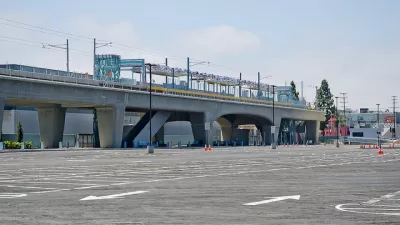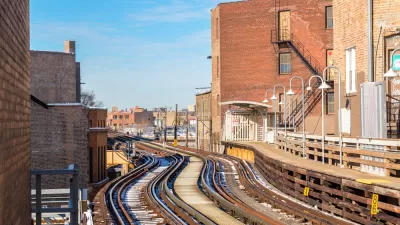A recently adopted ordinance allows developers to build significantly fewer parking spaces for projects in proximity to transit stations. Developers have already responded to the advantages offered by the reduced requirements.
According to Chris Bentley of Architect's Newspaper, an ordinance passed last fall in Chicago allows any residential developments within 600 feet of a transit station (or 1,200 on certain "Pedestrian Streets") to slash its parking requirements by 50 percent.
The first project taking advantage of this broke ground in July. As Bentley writes, "[t]he building will have 40 apartments... 2,500 square feet of commercial space, and 21 parking spaces—roughly half the amount of parking it would have been required to supply otherwise. 'Not having to put all these cars in there,' said firm principal David Brininstool, 'this is such a win-win for the city, the streetscape, and the developer.'"
Many other developers around the city have also taken advantage of the ordinance. One company, Wicker Park Apartments, "secured 16 percent more space by cutting parking—square footage that Brininstool said was a boon to the design team as they tried to shoehorn 40 apartments and commercial space into a triangular site with just 33 feet of street frontage. The angular site plan would have hamstrung the development’s density, which now boasts a 3.5 FAR at five stories tall."
FULL STORY: Take the Train

Maui's Vacation Rental Debate Turns Ugly
Verbal attacks, misinformation campaigns and fistfights plague a high-stakes debate to convert thousands of vacation rentals into long-term housing.

Planetizen Federal Action Tracker
A weekly monitor of how Trump’s orders and actions are impacting planners and planning in America.

San Francisco Suspends Traffic Calming Amidst Record Deaths
Citing “a challenging fiscal landscape,” the city will cease the program on the heels of 42 traffic deaths, including 24 pedestrians.

Bend, Oregon Zoning Reforms Prioritize Small-Scale Housing
The city altered its zoning code to allow multi-family housing and eliminated parking mandates citywide.

Amtrak Cutting Jobs, Funding to High-Speed Rail
The agency plans to cut 10 percent of its workforce and has confirmed it will not fund new high-speed rail projects.

LA Denies Basic Services to Unhoused Residents
The city has repeatedly failed to respond to requests for trash pickup at encampment sites, and eliminated a program that provided mobile showers and toilets.
Urban Design for Planners 1: Software Tools
This six-course series explores essential urban design concepts using open source software and equips planners with the tools they need to participate fully in the urban design process.
Planning for Universal Design
Learn the tools for implementing Universal Design in planning regulations.
planning NEXT
Appalachian Highlands Housing Partners
Mpact (founded as Rail~Volution)
City of Camden Redevelopment Agency
City of Astoria
City of Portland
City of Laramie





























